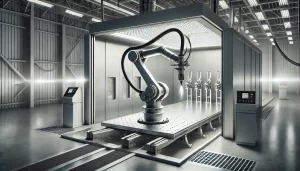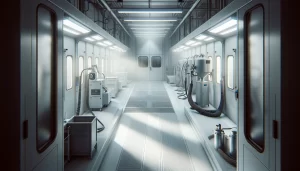If you operate a paint booth or manage any painting-related business, paint waste is probably one of your biggest headaches. Beyond the obvious financial cost, wasted paint impacts efficiency, productivity, and even your business’s environmental footprint. But here’s the good news: reducing paint waste doesn’t have to be complicated or costly. With a few simple changes, you can quickly minimize waste, save money, and boost your productivity.
Let’s take a closer look at practical, easy-to-follow methods you can implement to reduce paint waste in your paint booth today.
Why Is Reducing Paint Waste Important?
First things first—let’s talk about why managing paint waste matters. Paint is expensive, and every ounce wasted directly hits your bottom line. Besides the financial strain, excess paint waste increases disposal costs and harms the environment through unnecessary pollution. Moreover, a messy workspace due to overspray and drips reduces productivity and affects overall quality.
Reducing waste means better business efficiency, improved product quality, and significant cost savings. Plus, you’ll be taking steps toward more environmentally responsible practices, something customers increasingly value.
Optimize Your Paint Booth Setup
One of the easiest and most effective ways to reduce paint waste is optimizing your paint booth setup. Start by examining your booth airflow and filtration system. A poorly maintained filtration system allows overspray to accumulate excessively, resulting in more wasted paint. Regular maintenance of your filters not only improves airflow but also captures overspray more efficiently.
Make sure you have proper ventilation and that your spray booth is designed to minimize paint overspray. A well-engineered booth reduces turbulence, providing a smoother, more controlled environment. The result? Less overspray, better paint adherence, and less wasted product.
Master Your Spray Techniques
Even the most sophisticated equipment won’t reduce paint waste if your spraying technique isn’t optimized. Spraying paint efficiently requires some skill and a bit of practice, but the payoff is substantial.
First, ensure you’re always using proper spray techniques. Maintain the spray gun at the correct distance—typically around 6 to 10 inches from the surface—to reduce overspray and bounce-back. Spray perpendicular to the surface, moving in consistent, smooth strokes. Avoid holding the spray gun at an angle, as this increases overspray and uneven paint coverage.
Additionally, overlapping passes properly helps achieve uniform coverage without unnecessary buildup. Overlapping each stroke about 50% is typically recommended. This simple adjustment can significantly improve efficiency and reduce waste.
Choose High-Efficiency Spray Equipment
If you’re still using traditional spray guns, upgrading to a high-efficiency paint spraying system can dramatically cut down paint waste. High Volume Low Pressure (HVLP) spray guns, for example, are specifically designed to minimize overspray. HVLP guns transfer paint more effectively onto surfaces, reducing waste dramatically.
Compared to conventional spray guns, HVLP systems can reduce overspray by 20–40%. Less overspray means less paint wasted and more money saved. Additionally, HVLP spray guns are easier on the operator, resulting in higher-quality finishes and fewer mistakes.
Another option worth considering is Air-Assisted Airless spraying technology. These systems combine airless spraying’s speed and efficiency with better control and reduced overspray, ideal for businesses that want both productivity and reduced waste.
Mix Paint Precisely
Incorrectly mixed paint is a hidden source of waste many businesses overlook. Too often, painters mix more paint than necessary, resulting in leftovers that inevitably end up in the trash.
To combat this, implement precise paint measurement techniques. Invest in quality scales or mixing systems that allow your team to measure exactly how much paint each job requires. Using computerized paint mixing systems or carefully tracking historical paint usage for each job can help ensure you mix only what you need, eliminating unnecessary waste.
When measuring, remember to factor in the paint’s shelf life. By mixing paint in smaller batches and only mixing what you need immediately, you reduce waste significantly and keep your paint fresher and more effective.
Proper Storage and Handling
Paint waste isn’t just about what’s sprayed onto the booth walls or floor—it’s also about leftover paint, spoiled batches, and dried-out materials. Properly storing and handling paint can greatly reduce these forms of waste.
Store paint in airtight containers, clearly labeled with dates and batch details. This helps reduce the risk of paint spoiling or drying out, which leads to wasted resources. Train your employees to securely close lids, maintain a clean storage area, and regularly rotate your inventory, using older batches first.
Routine Maintenance Matters
Regularly maintaining your paint booth and equipment may seem like common sense, but you’d be surprised how often this crucial step is skipped. Proper maintenance extends the life of your equipment, ensures consistency in spray performance, and significantly reduces waste.
Check and clean your spray guns, hoses, and pumps regularly. Ensure filters, fans, and ventilation systems are clean and fully operational. Small maintenance tasks performed routinely keep your equipment functioning optimally, reducing paint waste and preventing costly downtime due to equipment failure or cleaning.
Remember, maintenance isn’t an expense; it’s an investment. Regular upkeep prevents larger issues and saves money in the long run by minimizing waste and improving efficiency.
Recycling and Reusing Leftover Paint
Even with the best practices, some leftover paint is inevitable. Rather than immediately disposing of leftover paint, consider recycling or reusing it. Many paint booth operators blend leftover paints into primers, base coats, or undercoats. Others partner with recycling companies specializing in paint reclamation, helping divert waste from landfills and reducing disposal costs.
By recycling or creatively repurposing leftover paint, your business can take significant strides toward becoming more sustainable, cost-efficient, and environmentally friendly.
Track and Review Your Progress
Finally, one of the most effective ways to minimize paint waste is by continuously tracking your usage, waste, and improvements. Regularly reviewing this information can help identify patterns, highlight areas for improvement, and pinpoint the most effective waste-reduction strategies.
Simple tools like spreadsheets or dedicated software can help you monitor how much paint your team uses, where the most waste occurs, and how your new practices improve efficiency over time. Regularly reviewing these metrics encourages accountability, motivates your team to continue improving, and helps sustain ongoing waste reduction efforts.
How We Can Help with Your Paint Booth Needs
At Paint Booth, we specialize in providing top-tier paint booths and finishing equipment tailored to your business requirements. Whether you need a standard-size paint booth or a custom solution designed for your unique projects, our expert team is here to assist you every step of the way. From design to installation, we ensure that your equipment meets the highest industry standards, enhancing both your productivity and the quality of your finishes. Contact us today to find the perfect paint booth solution for your business!




